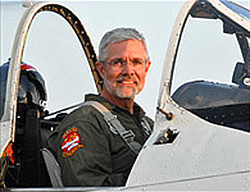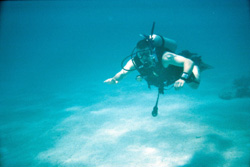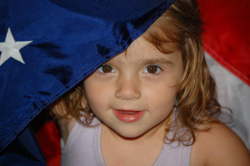 The Veterans Airlift Command provided air transportation for Sgt. Michael Blair and his wife, Delissa, to go on a diving trip in Florida.
The Veterans Airlift Command provided air transportation for Sgt. Michael Blair and his wife, Delissa, to go on a diving trip in Florida.
Sgt. Michael Blair was driving the last Humvee in a convoy headed for Haditha Dam on May 7, 2006. He was on his second tour in Iraq, stationed at the al Asad air base with the Seventh Marine Regiment. About a mile and a half from the dam, he saw a civilian vehicle in a military-only zone and turned off the road to pursue it. When the Humvee left the pavement, it triggered an improvised explosive device that blew the door off the vehicle and wounded Blair and his fellow Marines with shrapnel. It wasn’t until Blair went to get out of the truck and saw the two gaping holes in his camouflage that he realized the bomb had torn through his knees.
Blair was driven to Haditha Dam, where he was taken by helicopter to the al Asad medical facility. “And he’s gonna keep his legs, right doc?” Blair recalls his colonel saying to the surgeon at al Asad—it was a command, not a question.
Veterans Airlift Command
Learn more about Veterans Airlift Command from founder Walter Fricke in this AvWeb podcast.
Three years later, after more than 60 surgeries to replace and repair the bone, muscle, skin, and tendons destroyed in the blast, Blair, 34, walks with the help of crutches and braces on his legs. He has earned an advanced open water Scuba qualification, and is the area coordinator for Team River Runner, a veterans’ organization dedicated to health and healing through whitewater boating—he plans to use outdoor activities to help other injured veterans. After his last surgery this spring, he took his wife on a diving trip in Florida; the family traveled in a Gulfstream jet supplied by an aircraft owner through the Veterans Airlift Command (VAC), an organization that provides free air transportation to wounded veterans and their families.
When wounded warriors return to the United States for treatment, many are hundreds of miles away from family. Others need transportation to ceremonies recognizing their service or to activities that help them regain strength and confidence after a serious injury. The VAC provides them with transportation using a network of volunteer pilots and multi-engine or high-performance single-engine general aviation aircraft. VAC flights allow veterans to travel without the cost, inconvenience, or physical difficulty of a commercial flight and give pilots and aircraft owners a chance to express gratitude to soldiers who have been injured in the line of duty.
 Walter Fricke, a Vietnam veteran, created the Veterans Airlift Command in 2006.
Walter Fricke, a Vietnam veteran, created the Veterans Airlift Command in 2006.
About 1,000 pilots have flown close to 870,000 miles for the VAC since founder Walter Fricke, a Vietnam veteran, created the organization in 2006. Fricke, an instrument-rated commercial airplane and helicopter pilot with multi-engine land and sea ratings, spent six months in the hospital after being medevaced out of Vietnam in 1968. He was hospitalized 700 miles from his family and really began to heal when his family gathered the resources to come to visit him, he said. He thought of his own experience when he decided to coordinate transportation for those wounded in Iraq and Afghanistan.
‘The red carpet treatment’
When Blair arrived at Bethesda Naval Medical Center in 2006, within 48 hours of being injured in Iraq, his wife, nine-month-old daughter, mother, and grandmother were there waiting for him; and like many spouses of wounded veterans, his wife moved across the country—from California—to be with him through his rehabilitation. The family now lives in Silver Spring, Md., as Blair continues treatment at Walter Reed Army Medical Center. Blair took his wife and daughter, who is now 4, on the trip to Florida this May after meeting Fricke at a dinner for veterans hosted by the Aleethia Foundation.
“I knew of Walt, and I was trying to take my wife on a nice vacation,” Blair said. Diving and other outdoor activities have helped Blair heal, and he wanted to share the experience of diving with his wife. An aircraft owner offered up his jet and crew; another aircraft owner, a Marine who served in Vietnam, offered to host the family in his home. Blair’s mother watched the couple’s daughter in Miami while they dove in Tavernier, Fla. His wife earned her open water scuba certification on the trip.
 Blair has earned an advanced open water Scuba qualification, and his wife earned her open water qualification on the trip.
Blair has earned an advanced open water Scuba qualification, and his wife earned her open water qualification on the trip.
For wounded service men and women, traveling by commercial airline can be costly, cumbersome, and for some, a physical impossibility. Family members sometimes give up their jobs or take extended leave to be with their loved ones, and the cost of an airline ticket can be an additional burden. Because they may have prosthetics, crutches, or other medical devices, wounded veterans are often subject to additional screening at the security gate. And commercial airlines do not accommodate the medical equipment needed for the most severely wounded.
Blair has flown commercially, but he said he must put his crutches through the conveyer belt and go through additional screening. “Today, with TSA being the way they are, it’s hard,” he said. When he arrived at Dulles for his flight with the VAC, someone came out to carry his luggage and usher him onto the airplane.
“There was no pat-down, there was no scanner,” he said.
Fricke said wounded veterans can spend as much as 30 minutes going through airline security, whereas GA flights can accommodate them without subjecting them to security lines and wandings.
“We’re not punishing them by sticking them on an airliner,” he said. With the VAC, veterans can experience “going to the airport and meeting someone who’s taken his day and has taken his airplane at his own expense and is taking the red carpet treatment with this guy.”
 Blair received an e-mail before his VAC flight asking what his daughter, Mirabella, liked to eat. When the family arrived at the airplane, there were macaroni and cheese and chicken nuggets waiting for her.
Blair received an e-mail before his VAC flight asking what his daughter, Mirabella, liked to eat. When the family arrived at the airplane, there were macaroni and cheese and chicken nuggets waiting for her.
Blair said he received an e-mail before his VAC flight asking what his daughter liked to eat; when the family arrived at the airplane, there were macaroni and cheese and chicken nuggets waiting for her.
The use of small aircraft for the VAC allows those giving the flights to express gratitude to soldiers in a personal way—like the chicken nuggets or simply a good conversation. The flights mean much more to veterans than an airline ticket in the mail, Fricke said.
“They’re just blown away by the support that they get from the people that fly the missions,” he said. “… It’s very personal. It’s not an institution.”
Giving back
Pilots who fly VAC flights must have an instrument rating and a clean flying record. Some are Vietnam veterans who want to ensure this generation of veterans gets the support and appreciation it deserves; others simply want to give back to service men and women who have made sacrifices for their country.
Fricke said VAC flights can open the eyes of pilots who have not served in the military to the sacrifice that veterans endure. Participants in VAC flights have written about their experiences and the connections they have made on the VAC blog; many write that they feel honored to give a flight to a wounded warrior.
On a fuel stop in Frederick, Md., this summer, VAC participant Walter Gatti talked about his involvement in the organization and flying a wounded veteran.
“It’s really a humbling experience to see these kids,” he said. Gatti, the president of Tensor Engineering, uses his Falcon 20 for business and had flown it for local charities before he became involved in the VAC. “If it wasn’t for these kids and generations before us like that, we wouldn’t be here today doing what we’re talking about. … Why not help these kids out and show them a little appreciation?”


